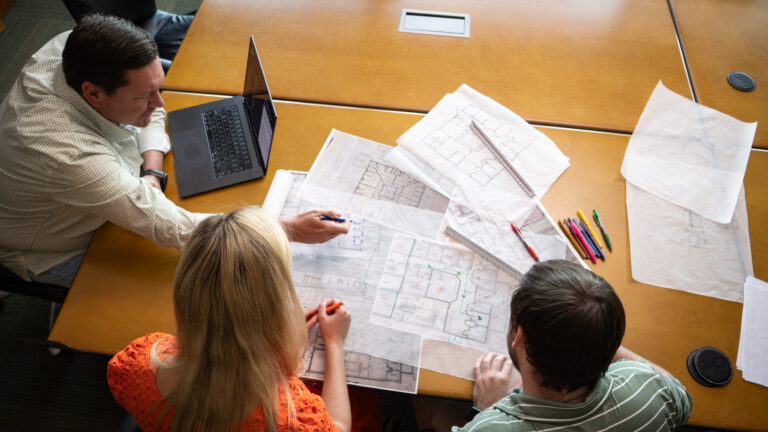Redefining Public Safety in Correctional Facilities: Beyond the False Choice

The dayroom of the north housing unit at James A. Musick Facility in Orange County, Calif., is designed with natural light and color to maximize the health and rehabilitation of the occupants. | Photo Credit (all): Kim Rogers, courtesy of HDR
By Brian Lovins, Ph.D.
For decades, our correctional system has operated under a fundamental misconception: That maximizing immediate security and control must come at the expense of the conditions that promote long-term success. This false dichotomy has shaped everything from facility architecture to operational policies, creating a self-defeating cycle where the pursuit of short-term safety actively undermines true long-term public safety.
The evidence is clear: Our current approach has failed on both fronts. Correctional staff experience some of the highest rates of post-traumatic stress disorder and suicide among all professions, with life expectancies significantly below the general population. Meanwhile, the national re-arrest rate for formerly incarcerated people hovers around 70%—a damning indictment of the system’s inability to fulfill its most basic public safety mandate.
Reframing the Conversation: Security and Wellness as Mutually Reinforcing Goals
It’s time to recognize a powerful truth: Environments that promote human dignity and wellness are inherently more secure. This isn’t idealism—it’s pragmatic, and supported by evidence from both domestic and international correctional models.
Designing facilities with clear sightlines that preserve dignity and personal space doesn’t mean sacrificing security for comfort—it means reducing the psychological pressures that fuel violence and self-harm. When we incorporate natural light, appropriate acoustics and thoughtful color schemes, we aren’t prioritizing aesthetics over function— we’re creating environments that reduce stress-induced aggression and support the mental health of everyone in the facility.

There is a fundamental contradiction in our current approach: We place people in environments known to increase trauma, aggression and mental deterioration, then expect those same environments to prepare them for a law-abiding life in the community. We subject our staff to chronically stressful, dehumanizing workplaces, then express surprise at high turnover rates and diminished performance.
A New Framework for Correctional Design and Operation
True public safety cannot be measured in 24-hour intervals of incident-free operation. It must be measured in successful community reintegration, reduced recidivism, and the physical and mental health outcomes of both incarcerated individuals and the staff who work with them.
Achieving this requires three fundamental shifts:
- Physical environments that balance security and humanity | Clear sightlines with more normalized spaces, appropriate acoustic management to reduce the constant nervous-system activation that drives violence, and access to natural light and greenery are all essential to reducing aggression and increasing stability.
- Operations that promote relationships and accountability | Smaller housing units create more manageable environments where relationships between staff and residents can develop, enhancing both immediate safety and rehabilitative outcomes. Technology should enhance targeted supervision of actual risks, not impose constant, dehumanizing surveillance that erodes mental well-being.
- A cultural shift in how we define safety | Trauma-informed approaches don’t compromise security; they enhance it by addressing the root causes of disruptive behavior. Normalized environments that approximate community living don’t undermine institutional control— they prepare individuals for the self-regulation required for successful reentry.
The Cost of Maintaining the Status Quo
The financial and human costs of our current approach are unsustainable. Each failed reentry isn’t just another crime statistic—it’s a cost multiplier across our criminal justice, healthcare and social service systems. Every staff member who leaves the profession due to burnout, dies by suicide or develops chronic health conditions, represents not just fiscal liability but also a lost investment in training and institutional knowledge.
But perhaps most significantly, our current system reflects a profound failure of imagination: the inability to see that security and wellness are not competing priorities but complementary goals. Integrated properly, they generate a virtuous cycle of improved outcomes for everyone involved.
Conclusion: Toward Holistic Public Safety
Ultimately, this isn’t about choosing between security and rehabilitation. It’s about recognizing that our narrow focus on immediate control has created a system that fails at both.
True public safety requires correctional environments designed and operated with a more sophisticated understanding—one that recognizes the interconnected nature of immediate security and long-term success.
By reimagining our approach through this lens, we can create correctional environments that protect communities not by temporarily containing individuals, but by addressing the underlying causes of criminal behavior while supporting the well-being of those tasked with managing these challenging environments. This isn’t just more humane— it’s more effective at delivering the public-safety outcomes that are the fundamental purpose of our correctional system.
Brian Lovins, Ph.D., is president of Justice System Partners and a nationally recognized leader in evidence-based correctional reform. He is a member of the Correctional News Editorial Advisory Board and the immediate past president of the American Probation and Parole Association. He has spent more than 30 years helping justice systems implement research-driven practices to improve outcomes for individuals and communities.
This article was originally published in the May/June Issue of Correctional News.






